26 Common Meeting Types And How to Run Them

More than half of us sit in meetings for at least four hours per week. And many teams hold the wrong meeting for the wrong reasons and in the wrong way. That’s a lot of wasted time.
However, schedule the right type of meeting for the right reasons in the right way, and meetings become worth the time invested.
As the dictionary eloquently states:
A meeting is: “a coming together of two or more people, by chance or arrangement.”
This resource of meeting types only includes formal, scheduled meetings for people working in the same organization.
We hold these meetings to collaborate: share information, make decisions, nurture relationships, solve problems, and come up with ideas.
But too often, meetings are boring and don’t serve their purpose. They have the wrong attendees or too many of them. There’s no clear purpose or agenda. And, as Harvard Business Review observed in 1976, “in most meetings someone takes a long time to say very little.”
You can resolve many of these issues by understanding the different types of meetings and their purpose, and choosing the one that best serves your purpose.
Different types of business and work meetings
We’ve put together an overview of the 26 most important work meetings and the goals they can serve, so you can have more effective meetings.
You can use the table of contents below to jump to the five main categories. Each one includes several types of meetings along with its purpose and facilitation tips:
Project management meetings
Product and project management meetings help teams plan, execute, check, and deliver their work.
Overview of product and project management meetings:
1. Brainstorming session
- 👯♀️ Synonyms and similar meeting types: Problem-solving meeting, innovation meeting, design sprint, ideation meeting
- 🎯 Goal: Problem solving and idea generation
Brainstorming meetings tap into the creativity and expertise of a group to come up with ideas or solve a problem. By involving folks with different backgrounds, skills, and perspectives, these meetings help you find solutions you can’t come up with by yourself.
Examples of topics a brainstorming session can cover:
- Coming up with new feature ideas for your product.
- Ideating concepts for an upcoming marketing campaign.
- Finding solutions for improving an inefficient internal process.
💡 Tips for brainstorming meetings:
- Define a clear goal or problem statement. You need to make sure every attendee has the same understanding of the problem you’re trying to solve. “Increase revenue” isn’t clear. “Find new sales approaches for our student persona” is.
- Let people first generate ideas alone. As Teresa Torres writes in Continuous Discovery Habits, many studies have found that individuals generate more diverse and original ideas than groups. Let folks write out ideas by themselves first, then use the group to refine, combine, and select the best ones.
- Encourage ‘terrible ideas’. Wild suggestions often lead to unexpected yet viable follow-up ideas. Make people comfortable sharing such thoughts by not assessing their feasibility early in the meeting and encouraging senior folks to go first with some wacky ideas; others will then follow.
📚️ Further reading (and listening)
- The Daily Show’s Secret to Creativity (podcast by Adam Grant)
- Brainwriting (MindTools)
- Applied Imagination, a book by Alex Osborn that introduced the idea of brainstorming.
2. Project planning meetings
- 👯♀️ Synonyms and similar meeting types: Product roadmap planning, project discovery
Project planning meetings bring together all of the different stakeholders involved in a project. A project manager usually drives and leads these sessions to gather information, decide on a project’s scope, and determine what’s needed to deliver on the project’s objectives. You then work together with everyone to agree on a timeline for the deliverables.
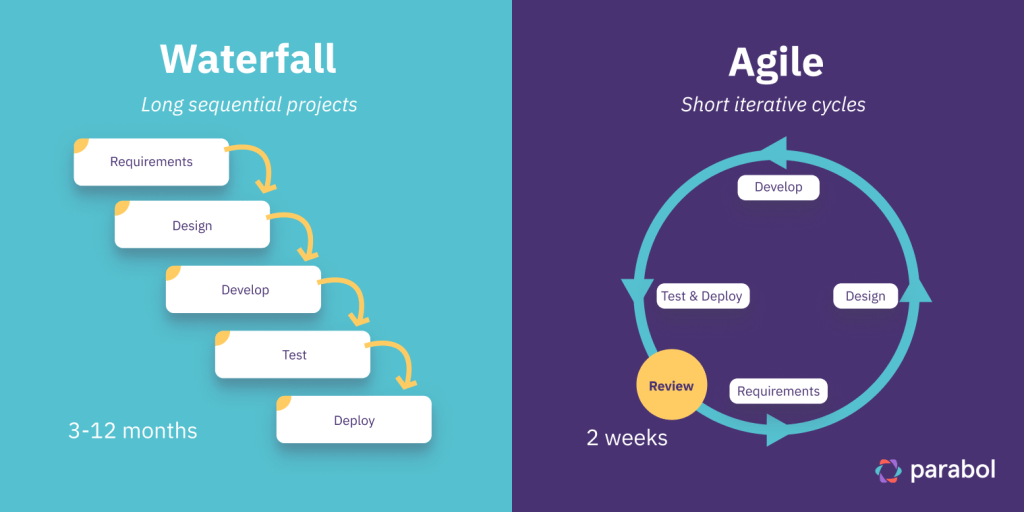
Depending on the size of the project, planning meetings can span several sessions across weeks or even months, involving many people and teams.
Examples of projects a planning meeting can cover:
- Organizing an event, like a webinar or conference.
- Designing and developing of a new website.
- Launching a new product.
💡 Tips for Project planning meetings:
- Consider an agile approach. Project planning sessions are a staple of the waterfall model, in which every project phase and task moves sequentially. Such a method works well when the project is predictable–these days, few are. Agile thrives in complex and unpredictable circumstances because of its short, iterative cycles.
- Include a premortem. Dedicate some meeting time–or a separate event–to a premortem to identify the most significant risks of your project. (“Imagine we’re at the end of the project, and it’s a failure. What went wrong?”) Then create contingency plans for everything you think could go wrong, so it doesn’t.
📚️ Further reading
- How I Run Project Planning Meetings (Tactical Project Manager)
3. Kickoff meetings
- 👯♀️ Synonyms and similar meeting types: Launch meeting
The kickoff meeting marks the start of a project. Its purpose is to bring the entire team together, highlight milestones and other agreements from the planning process, and ensure everyone is clear on their responsibilities and objectives.
💡 Tips for Kickoff meetings:
- Don’t conflate project planning and kickoff. Unless you’re doing a small project, it’s most effective to keep the two meetings separate. Otherwise, the kickoff meeting becomes a draining and confusing event instead of an energizing and clear start to your project.
📚️ Further reading
- Project Kickoff Meeting (Adobe)
- How To Run Project Kickoff Meetings: The Ultimate Guide (The Digital Project Manager)
4. Check-in meetings
- 👯♀️ Synonyms and similar meeting types: Status update meeting, progress reviews, product reviews
- 🎯 Goals: Accountability, information gathering and sharing
Managers hold check-in meetings to monitor a team’s or individual’s progress against earlier-agreed objectives – say, during project planning. Sometimes such events are for information gathering. But their underlying function is usually to enforce accountability so people stay on track.
Check-in meetings are often planned at recurring intervals, such as weekly or monthly, with the same attendees. You can also use these gatherings to clarify next steps or address challenges if they involve the entire group.
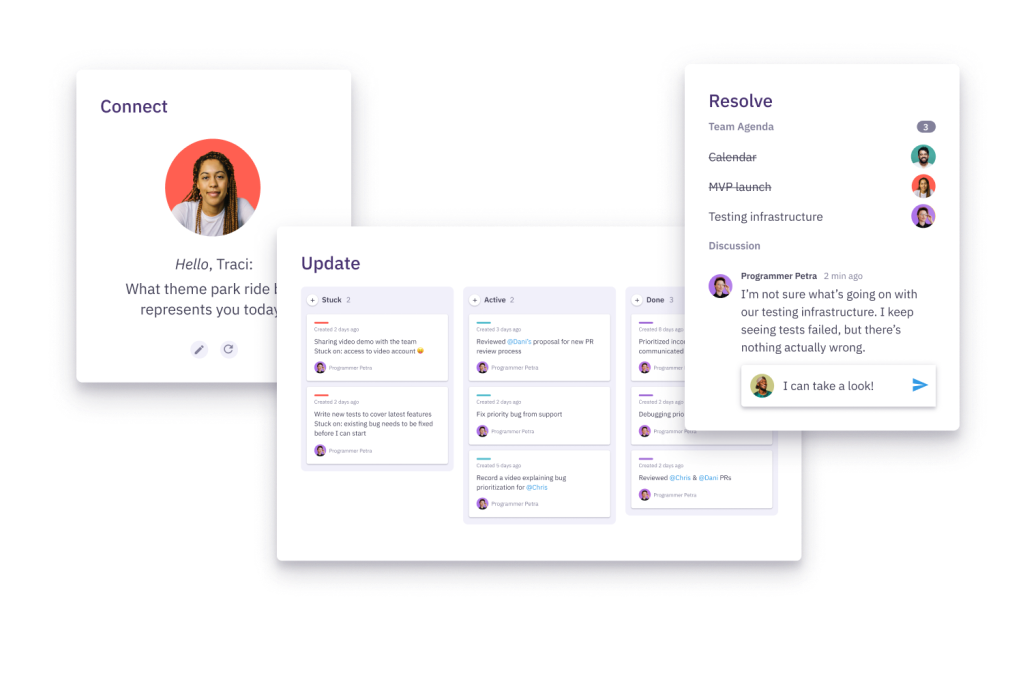
Examples of topics a check-in meeting can cover:
- Checking the progress of a project against the original plan.
- A product demo to see what the team has developed since the last review.
- A weekly meeting that looks at critical business and project metrics.
💡 Tips for check-in meetings:
- Be clear about intention. Understand if you’re holding a check-in meeting to gather information or enforce accountability. This will help you structure the meeting’s agenda and format.
- Consider going async. Suppose the emphasis of the meeting’s intention is to gather information. In that case, check-in meetings can be done async via updates in a spreadsheet or chat channel. People can then share these updates at a convenient time and free up their schedules.
📚️ Further reading
5. Daily huddle meetings
- 👯♀️ Synonyms and similar meeting types: Daily meeting, daily standup meeting
- 🎯 Goals: Planning, accountability, relationship building and maintenance, information gathering and sharing, decision making, problem solving
The daily huddle is a short meeting that teams or companies hold every day to sync up on their work. These gatherings usually don’t last more than 15 minutes and often happen in person or over a call.
In most organizations, the huddle is a daily pulse check on goals from larger, less frequent meeting types.
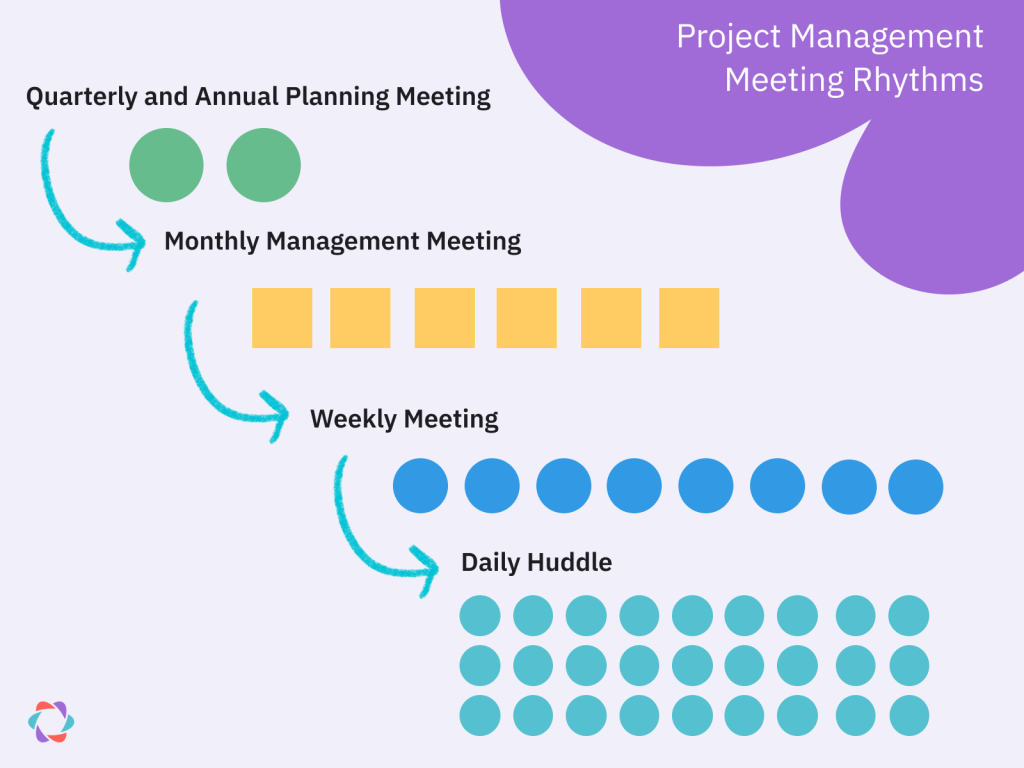
Examples of topics a Daily Huddle meeting can cover:
- Track progress toward goals and metrics.
- Create clarity, focus, and accountability for the day’s work.
- Remove blockers quickly because people have a daily chance to bring them up.
💡 Tips for Daily Huddle meetings:
- Keep the agenda light. Cut questions or items from your huddle’s agenda if it frequently passes 15 minutes.
- Look forward, not backward. You want to talk about what’s ahead instead of getting status updates on things that have happened.
- Find problems, don’t solve them. The meeting is for identifying and highlighting issues. Problem solving can happen afterward.
📚️ Further reading
6. Tactical meetings (Holacracy)
- 👯♀️ Synonyms and similar meeting types: N/a
- 🎯 Goals: Information gathering and sharing, decision making, problem solving
Holacracy is a method for running organizations through decentralized management. Weekly tactical meetings are an essential component of the system.
Brian Robertson in Holacracy“If you know what you need to do next and nothing is in your way, just go do it. If you know who you need to talk to in order to move a project forward, just talk to them. But if you’re not sure what to do and want some help, or haven’t had a chance to coordinate with the right people during a busy week, the weekly tactical meeting provides a fallback.”
These events have a rigid structure and combine elements from other meeting types, like checking in on metrics and task statuses, while allowing participants to solve problems and make decisions.
A typical tactical meeting agenda looks like this:
- Check-in Round
- Checklist Review
- Metrics Review
- Progress Updates
- Agenda Building
- Triage Issues
- Closing Round
💡 Tips for tactical meetings:
- Enlist an experienced facilitator. Holacracy has strict–almost ruthless–rules for running its meetings. For example, when checking in on completed action items, people can only answer “check” (done) or “no check.” The facilitator should immediately cut off any other talk.
- Familiarize everyone with Holacracy beforehand. Because of the strict and atypical rules just mentioned, people need to become familiar with at least the basics of Holacracy before diving into a tactical meeting.
📚️ Further reading
- Tactical Meetings (Holacracy website)
- Free Online Tool for Tactical Meetings (Parabol)
7. Incident postmortem meetings
- 👯♀️ Synonyms and similar meeting types: Postmortem meeting
- 🎯 Goals: Learning and improvement, problem solving and idea generation
You hold an incident postmortem meeting after you’ve resolved a problematic situation. Doing so allows everyone involved to extract learnings from the incident and define ways to prevent them from happening in the future.
Examples of incidents a postmortem meeting can cover:
- A critical server went down during peak season.
- A key customer unexpectedly canceled.
💡 Tips for incident postmortem meetings:
- Involve diverse stakeholders. You want different perspectives in a postmortem, not only from the team that’s directly involved. Say a server outage affected your customers’ online sales. In that case, you need engineers in your postmortem. You also want the customer support people who spoke to the affected clients and can represent their views in the meeting.
- Don’t assign blame. Postmortems only work when participants know their contributions won’t be used to punish them. Focus on how to improve processes and responsibilities in the future; don’t dwell on the past.
📚️ Further reading
- Running Successful Incident Postmortems (Parabol)
8. Lessons learned meetings
- 👯♀️ Synonyms and similar meeting types: Retrospective meetings, project postmortems, after-action reviews
- 🎯 Goals: Learning and improvement
In a lessons-learned meeting, a team comes together to review a project, milestone, or Sprint to discover what did and didn’t go well. They can apply these learnings to future projects and share them across the organization.
Teams take lessons learned into account in future projects, and they can also be shared across the organization. Lessons learned meetings typically happen at the end of a project or on a fixed cadence. You can also hold a review meeting in the middle of a large project whenever you complete a milestone.
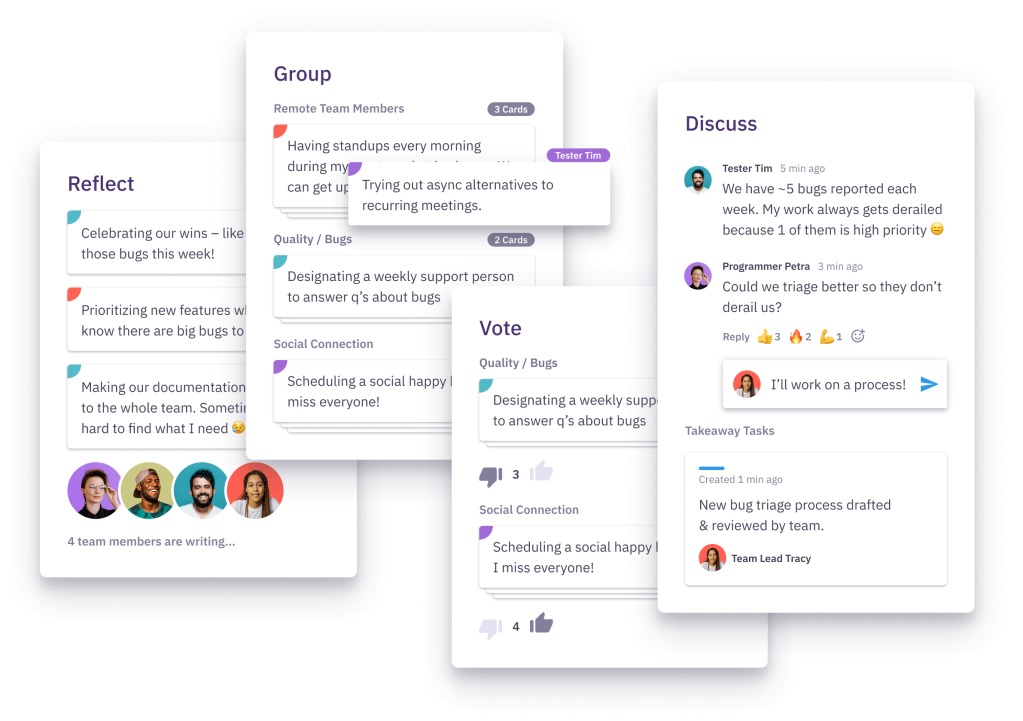
Examples of topics a lessons learned meeting can cover:
- Analyze reasons for missing certain project milestones.
- Uncover how you were able to deliver early.
💡 Tips for lessons learned meetings:
- Agree that what happens in the meeting stays in the meeting. What’s shared during the meeting isn’t held against someone later and not communicated afterward to anyone else.
- Use a lessons-learned template with open questions. Without such prompts to guide people’s thinking, you’ll end the meeting without valuable insights.
📚️ Further reading
- 35+ Lessons Learned Meeting Templates (Parabol)
Agile meetings
We consider any event that’s part of an Agile framework, methodology, or theory an agile meeting. Anyone can benefit from these meetings – not just agile teams.
Overview of Agile meetings:
9. Sprint Planning
- 👯♀️ Synonyms and similar meeting types: N/a
- 🎯 Goals: Planning, information gathering and sharing, decision making
During Sprint Planning, Scrum teams decide which are the most valuable Product Backlog items to deliver in the next Sprint.
Sprint Planning ensures teams have enough direction and structure to know what to work on next. The event eliminates the need for long-term plans that are often inflexible, unrealistic, or become obsolete due to changing customer and business priorities.
“Parabol has made a massive difference. Our retrospective and sprint planning meetings are more consistent, productive, and enjoyable. It keeps our meetings flowing, no matter who is leading them.”
The Sprint Planning meeting happens at the start of the Sprint. It can last one to two hours for a two-week Sprint.
💡 Tips for Sprint Planning events:
- Draft a preliminary Sprint Goal. The Product Owner should come to the event with a draft Sprint Goal prepared. This prevents the task of “finding a goal” from taking up most of the meeting.
- The team should know their capacity for the Sprint. Factors like vacations, holidays, illness, training, resignations, and new hires will affect the amount of work the team can do and the Sprint’s potential scope.
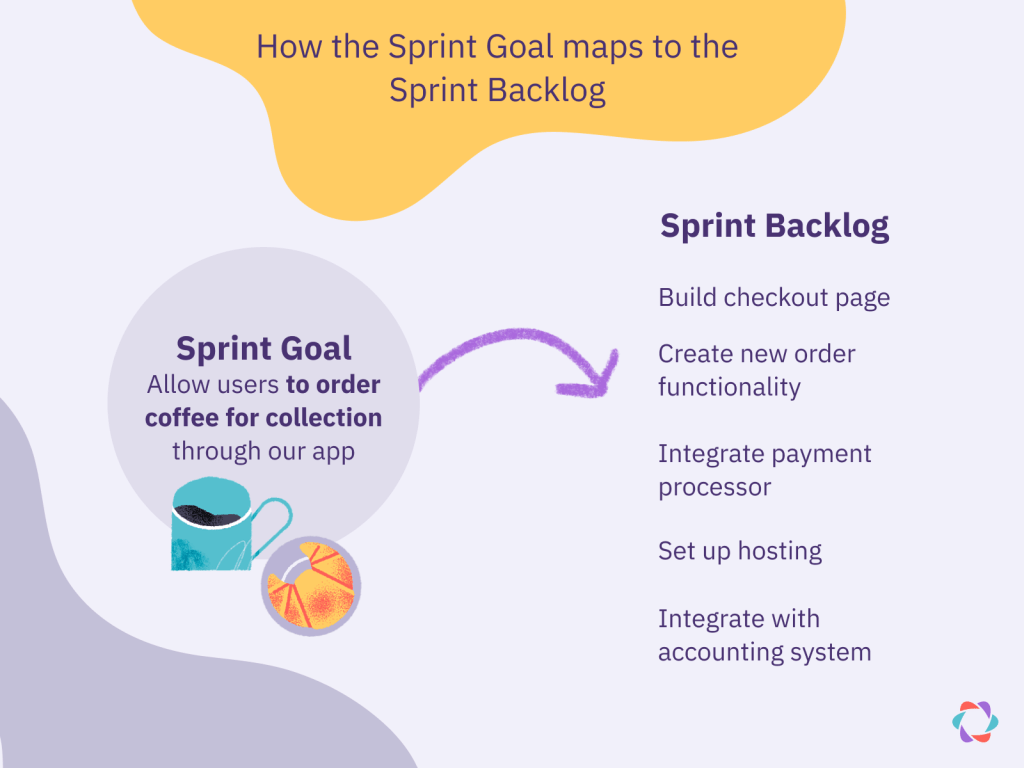
📚️ Further reading
10. Backlog refinement
- 👯♀️ Synonyms and similar meeting types: Backlog grooming
- 🎯 Goals: Planning, information gathering and sharing, idea generation
Backlog Refinement is a process by which teams add detail to items in their Product Backlog so it includes all the information required for work to begin.
Some agile practitioners don’t consider backlog refinement a meeting because the Scrum Guide refers to it as “an ongoing process.” Other teams make backlog refinement a recurring, formal meeting to ensure that it happens often and not at the last minute before Sprint Planning.
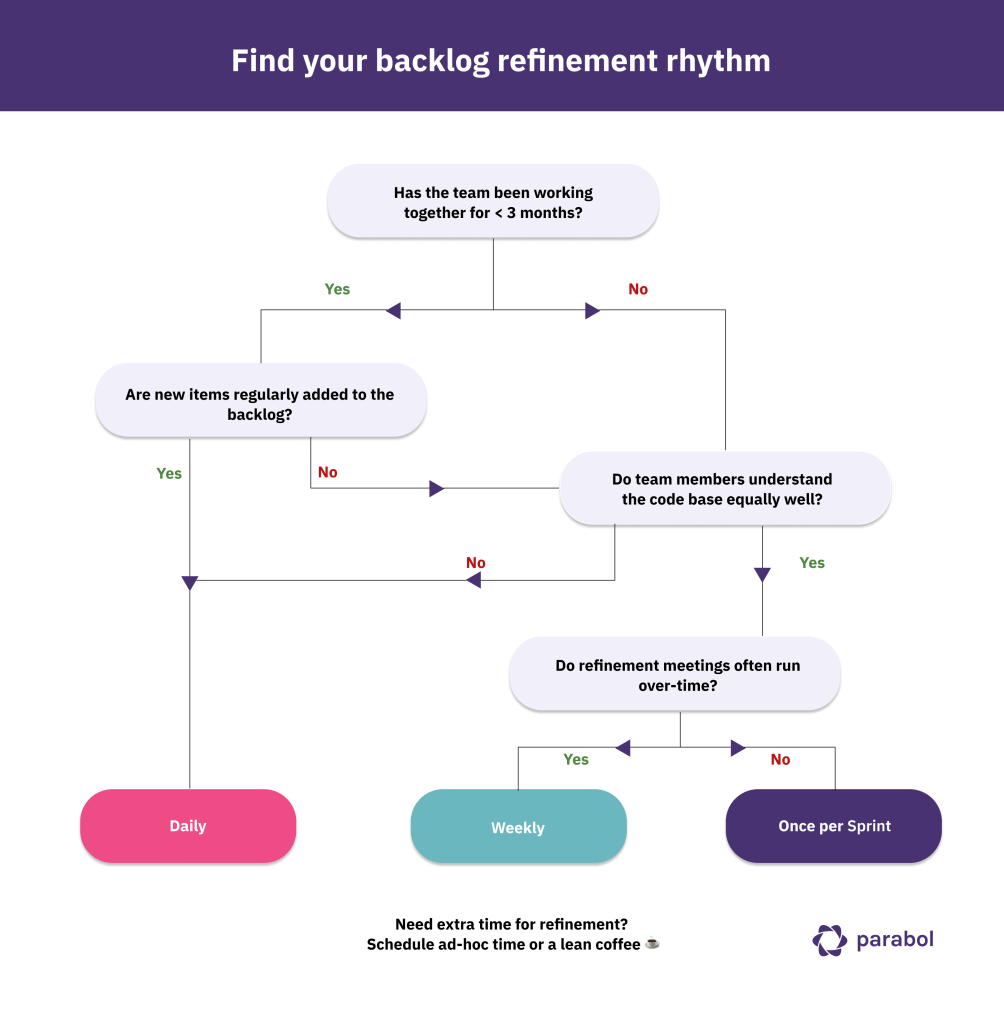
📚️ Further reading
- What is Backlog Refinement? (Parabol)
- When Should Backlog Refinement Happen? (Parabol)
11. Planning Poker
- 👯♀️ Synonyms and similar meeting types: Sprint Poker, Agile estimation
- 🎯 Goal: Planning, information gathering and sharing, decision making, idea generation
Planning Poker is a meeting during which teams estimate how large or small various tasks and projects are using a set of poker cards.
Teams review a selection of user stories or tasks from the product backlog. Then each participant individually estimates how much effort that task will involve. Teams do this by playing cards with different values from a customized deck.
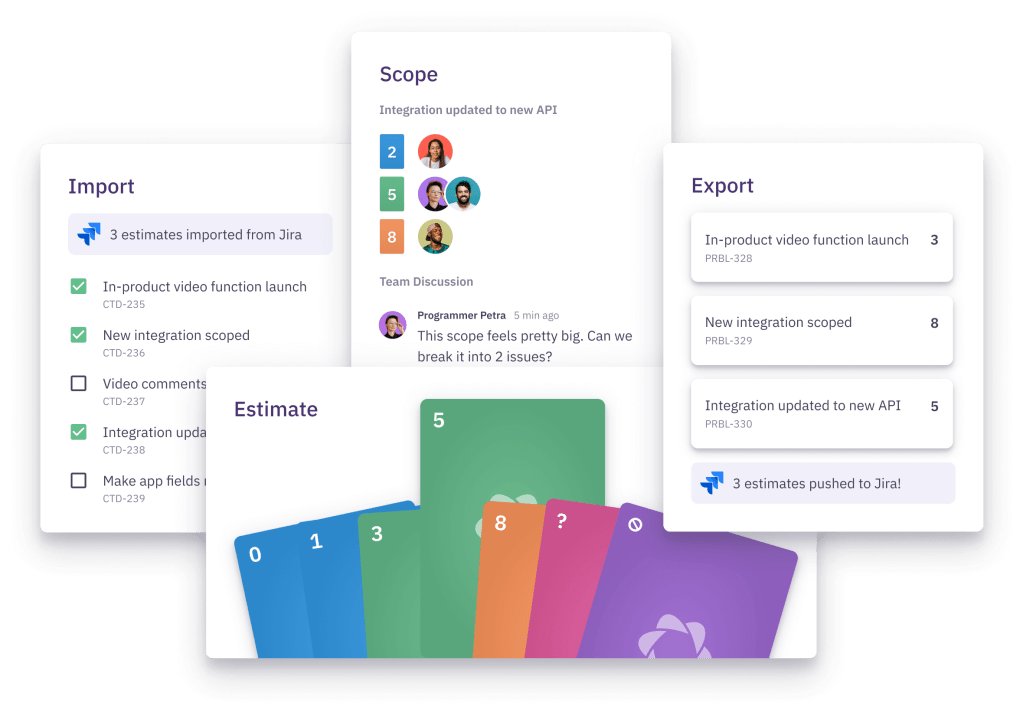
💡 Tips for Planning Poker meetings:
- Only people with awareness and context vote. People without knowledge of a task or project can’t give a helpful estimate or can drag out the discussion with their questions.
- Vote anonymously. Nobody sees anyone else’s selection until everyone has voted. Hidden voting helps to prevent an anchoring bias that could skew estimates.
📚️ Further reading
12. Daily Scrum or standup
- 👯♀️ Synonyms and similar meeting types: Daily Standup, Daily Huddle, “The Daily”, Daily meeting
The Daily Scrum is a 15-minute time-boxed event held every working day of the Sprint at the same time and place.
The goal of the meeting is to create clarity on the day’s work, adjust plans, and engage in some quick problem solving. The focus of the Daily Scrum should be on looking ahead at how to tackle the day rather than giving status updates on what the team completed the day before.

💡 Tips for Daily Scrum meetings:
- Keep it short. If you speak for more than 90 seconds, try to resolve the issue outside the meeting.
- Optimize the Daily Scrum timeslot. Since the meeting should serve its participants and not their manager, they should choose when and how to hold the meeting. For example, before lunch might work better than earlier in the day since that gives everyone an uninterrupted block of work time in the morning.
📚️ Further reading
- Daily Scrum: Complete Beginner’s Guide (Parabol)
- Free Daily Standup Tool for Remote Teams (Parabol)
13. Sprint Review
- 👯♀️ Synonyms and similar meeting types: Sprint Demo
- 🎯 Goals: Accountability, information sharing, decision making, learning and improvement
The Sprint Review showcases the Scrum team’s work from their Sprint. Sprint Reviews take place at the end of the Sprint before the Sprint Retrospective.

During a Sprint Review, the team collects feedback on their work from stakeholders. During this meeting, the team determines if they met the Sprint Goal and discuss how to improve the product in future Sprints.
💡 Tips for Sprint Review meetings:
- Showcase working software. Sprint Reviews should allow stakeholders to give feedback on real products, not demos or props that lack functionality.
📚️ Further reading
14. Sprint Retrospective
- 👯♀️ Synonyms and similar meeting types: Lessons learned meeting, project postmortem
- 🎯 Goal: Learning and improvement
Agile teams use Sprint Retrospectives to review their work together and identify opportunities for process improvements. Teams hold a Sprint Retrospective at the end of every Sprint.
Anything is up for review and discussion during the Sprint Retrospective, including working relationships, interactions, processes, and tools.
Team members first suggest topics for discussion, usually by writing their thoughts down on cards. They then group these into themes and vote on which ones they want to discuss.
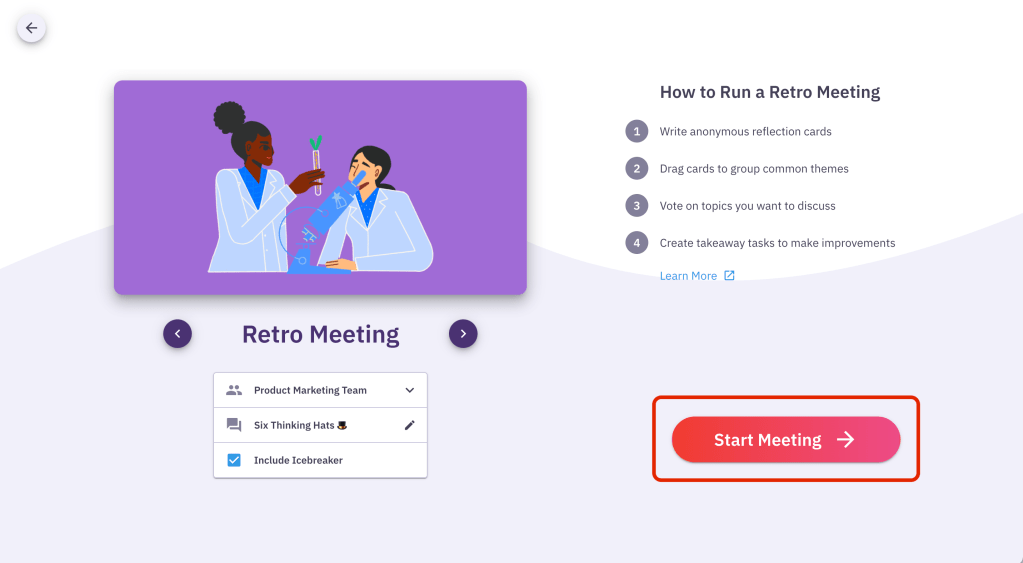
💡 Tips for retrospective meetings:
- Try new retrospective formats. Going through the same meeting agenda every time puts everyone on autopilot. A new format is the best way to refresh your retrospectives and get more valuable input from everyone.
- Run an asynchronous retrospective. You don’t need to be together in real time for the entire duration of a retro. With remote meeting tools like Parabol, you can do an asynchronous retrospective, which is easier to plan for teams distributed across time zones.
📚️ Further reading
Operations meetings for middle management
Meetings for operations and middle management keep the company running. In these events, you create strategies, sync up between teams, and look at higher-level performance and business metrics.
Overview of meetings for operations and middle management:
15. Strategy planning meetings
- 👯♀️ Synonyms and similar meeting types: Strategy off-site, off-site retreat
- 🎯 Goal: Planning, decision-making, problem solving and idea generation
Strategy planning means you’re devising a plan to reach a specific objective. You can do this at the company level – the overall business strategy – and within a team, say, the marketing strategy for Q4.
Typically, strategy planning happens in a dedicated meeting. Its length and frequency depend on the challenge to be tackled.
For example, overall company strategy planning happens on an annual rhythm, often with executives going off site or offline, sometimes for multiple days.
Coming up with a Q4 marketing strategy can generally be done in a handful of one to two-hour meetings over a period of one or two weeks at most.
Examples of topics a strategy planning session can cover:
- Annual company strategy.
- Quarterly strategy planning and review.
- Strategy for entering a new market (go to market strategy).
💡 Tips for strategy planning meetings:
- Don’t consider them a luxury. Organizations often view strategy retreats as a luxury they can only afford when times are good. In reality, stepping out of the day-to-day to plot a new course when facing challenges is even more critical.
- Restrict the use of devices. Strategy planning involves taking a long-term view of the business or a situation by removing yourself from the day-to-day worries of managing. There’s no better way to undermine your ability to do so than by staying plugged into a constant stream of messages coming in through your phone.
📚️ Further reading
- What You Must Do (and NEVER do) During Strategic Meetings (Growth Institute)
16. Management meetings
- 👯♀️ Synonyms and similar meeting types: Management team meeting, leadership meeting, executive meeting
- 🎯 Goal: Accountability, information gathering and sharing, decision making, problem solving
A management meeting brings together the highest level managers of a company or, at larger organizations, a department. Its format can differ, but usually, these meetings involve reviewing metrics and project progress, solving problems, and making decisions.
Management meetings are typically held weekly on the same day and time and follow a fixed agenda.
Examples of topics a management meeting can cover:
- Company KPIs review.
- Reviewing and approving an HR policy that affects the entire company.
- Updates on key customer accounts.
💡 Tips for management meetings:
- Prepare well (and delegate). The larger your company, the more expensive this meeting is. The salaries of the attendees tend to be the highest in the organization. Preparing well so the meeting runs smoothly literally pays off, especially when an executive assistant or chief of staff does most of that work.
- Focus on problem solving and decision-making. Since the time of all attendees in this meeting is so valuable, consider removing mundane metric reviews and status updates. Instead, focus on thorny issues or exciting opportunities that deserve the attention of the highest level folks in the organization.
- Make the meeting transparent. Management meeting attendance is often a status symbol and source of power. You can counter these effects by sharing items from the meeting across the organization, like the agenda, outcomes, and other materials attendees can access.
📚️ Further reading
- The Ultimate Guide to Running Executive Meetings — 25 Tips from Top Startup Leaders (First Round Review)
- Stop Wasting Valuable Time (HBR; published in 2004, but the advice still holds true)
17. Team meetings
- 👯♀️ Synonyms and similar meeting types: Team huddle
- 🎯 Goals: Accountability, relationship building and maintenance, information sharing, decision making, learning
Most teams hold team meetings and have many reasons for doing so.
First, regularly bringing the group together ensures everyone feels they belong to a team. Once together, some teams review essential projects and metrics they’re collaborating on. Other groups might share learnings, say when you’re on the same team but work for different customers.
Team meetings often happen weekly, but other rhythms and ad hoc gatherings are possible, too.
Examples of topics team meetings can cover:
- Review of critical metrics, projects, or product roadmap.
- Knowledge and skill sharing.
- Tweak an inefficient work process that affects the team.
💡 Tips for team meetings:
- Hold the team accountable. Challenge the entire group when their performance is lacking, not individual members. You should address personal performance issues in a one-on-one.
- Equalize the experience. Make the meeting virtual when part of your team is in the same office while the rest is not. This way, everyone has the same context, instead of the remote team members feeling like outsiders.
📚️ Further reading
18. Sales review meetings
- 👯♀️ Synonyms and similar meeting types: Sales pipeline review, sales forecast review
- 🎯 Goal: Planning, accountability, information gathering and sharing
Most organizations hold sales meetings weekly. Each sales team member shares how prospects are progressing through the sales pipeline during this gathering. At Parabol, we call this meeting “Deals, Deals, Deals!”
This meeting is an opportunity for team members to discuss best practices with each other. In most cases, its primary purpose is for the sales leader to stay on top of everyone’s sales performance and test how realistic each member’s forecast is.
Examples of topics sales review meeting can cover:
- Sales pipeline review, including critical sales metrics.
- Revisiting company goals and sales objectives.
- Closed and lost deals review.
💡 Tips for sales review meetings:
- Don’t forget about bright spots. It’s easy for this meeting to become a dreaded weekly ritual where a leader probes sales managers on their prospects and only focuses on losses. Instead, remember to make time to celebrate wins, share successful sales tactics, and highlight happy customers.
- Invite guests from other teams. A sales department can become an island within the organization since they’re either on calls or on the road. To avoid such siloing, consider inviting guests from other departments to the sales meeting, for example, to give a demo of a new feature or share the product roadmap in person instead of by email.
📚️ Further reading
- Guide: Weekly sales review meeting (Almanac)
19. Governance meetings (Holacracy)
- 👯♀️ Synonyms and similar meeting types: Decision-making meeting
- 🎯 Goals: Accountability, decision-making
Like the tactical meeting type we reviewed under product and project management meetings, governance meetings are a specific meeting type from Holacracy.
In traditional meetings, people often get assigned new responsibilities masquerading as projects and tasks. Say your boss tells you to “keep an eye on our website’s Google Analytics from now on.”
While that sounds innocent enough, it can be a significant, ongoing responsibility you now have that was never part of your original job description.
Holacracy deals with such role-scope changes in separate governance meetings. These gatherings aim to amend roles that individuals hold and those of what Holacracy calls “circles”–roughly translatable as a team or department in traditional organizations.
These meetings help clarify responsibilities and give people a way to accept or reject the “scope creep” of their roles.
Topics a governance meeting can cover:
- Creating, amending, or removing roles within the circle.
- Creating, amending, or removing policies governing the circle’s domain.
- Electing circle members to fill elected roles (facilitator, secretary, and rep link).
- Creating, amending, or dissolving sub-circles.
💡 Tips for governance meetings:
- Enlist an experienced facilitator. Holacracy has strict–almost ruthless–rules for running its meetings. For example, during governance meetings, operational topics are not allowed and should immediately be cut off by the facilitator.
- Familiarize everyone with Holacracy beforehand. Because of the strict and atypical rules of Holacracy, people need to become familiar with the method’s basics before attending a governance meeting.
📚️ Further reading
- Governance Meetings (Holacracy)
HR and people-management meetings
HR and people management meetings help people grow, recover, or bond–if they’re done right and for the right reasons.
Overview of HR and people management meetings:
20. Onboarding meetings
- 👯♀️ Synonyms and similar meeting types: Orientation meetings
- 🎯 Goal: Relationship building, personal development, information sharing
Onboarding meetings are the workplace equivalent of first dates. New hires feel nervous and excited about joining a new company and meeting many of their coworkers for the first time.
Onboarding meetings should help calm those nerves. These gatherings give people a great first impression of the organization and familiarize new employees with how to do their work and operate within the company.
Examples of topics an onboarding session can cover:
- Explanation of important procedures related to HR, finance, and other operational logistics.
- Meet & greet with other team members and departments.
- Training on the apps your organization uses every day.
💡 Tips for onboarding meetings:
- Impress, but don’t overwhelm. You want to give new employees a great impression on their first day. But remember that they have a lot to take in, so don’t pack the day so full that they go home exhausted.
- Assign a mentor or buddy. People will have questions after their first day or week. Even during that period, HR can only answer some queries. A dedicated buddy or mentor for the first weeks or months can ensure the new team member always has someone to turn to for answers and advice.
📚️ Further reading
21. One-on-one meetings
- 👯♀️ Synonyms and similar meeting types: 1:1
- 🎯 Goal: Relationship building and maintenance, personal development
One-on-one meetings between boss and employee can be awful. The manager might lecture instead of listen, the subordinate might complain about coworkers, or the boss makes promises they don’t keep.
Ben Horowitz in One on One“People who think one-on-one meetings are a bad idea have been victims of poorly designed one-on-one meetings. The key to a good one-on-one meeting is the understanding that it is the employee’s meeting rather than the manager’s meeting.”
You can resolve most of these issues by letting the employee own the meeting’s agenda. Make it their meeting, and ensure they do most of the talking. Also, try to keep out operational topics, or tackle them if the employee thinks they’re pressing and there’s some time left at the end.
Examples of topics a one-on-one session can cover:
- What’s on the employee’s mind, like problems, ideas, or aspirations.
- Informal discussion about career trajectory and growth.
- Open, personal action items that don’t fit within the context of a project or team meeting.
💡 Tips for one-on-one meetings:
- Have no agenda. When you both feel an unstructured talk is comfortable and valuable, a 1:1 is the only meeting type that works well without an agenda.
- Have a trigger. The employee should own the agenda. But if they’re hesitant to bring up any topics, the manager can prompt them with trigger questions, like, “What can we as a team improve?” “What are you happy about achieving last month?” “What’s something you’re looking forward to?”
- Avoid complaints about peers. As a manager, you want to avoid becoming stuck between two people or parties complaining to you instead of talking it out with each other. Suggest they discuss the matter with each other first, and, if that fails, bring them together to resolve the case in your presence.
📚️ Further reading
- Managers, Take Your 1:1s to the Next Level with These 6 Must Reads (First Round Review)
22. Performance review meetings
- 👯♀️ Synonyms and similar meeting types: Feedback meetings
- 🎯 Goal: Accountability, personal development
Formal performance reviews usually involve a written evaluation of an employee that you then discuss in a meeting. They’re hallmarks of hierarchical, traditionally managed organizations and are still surprisingly common.
Nobody likes these meetings. They imply managers should give feedback on a quarterly or annual frequency. Yet regular, immediate feedback is much more effective and motivating.
Another problem is that performance reviews suffer from recency bias, meaning events close to the meeting will get much more weight than those that happened long ago.
Examples of topics a performance review can cover:
- Review achievements
- Define areas for improvement
- Review and set goals
💡 Tips for performance review meetings:
- Don’t surprise. Nobody should be shocked by the contents of their performance review. A good manager serves feedback hot instead of cold–as soon as possible after a positive or negative event.
- Make clear agreements. Don’t settle on vague statements during a performance review, like “improve your strategic thinking” or “drive more sales.” Make objectives concrete with clear language and metrics.
📚️ Further reading
- How to Give the Most Effective Feedback (Center for Creative Leadership)
23. Team building meetings
- 👯♀️ Synonyms and similar meeting types: N/a
- 🎯 Goal: Relationship building and maintenance, personal development
Team building meetings strengthen bonds between team members. They can be as small as a team lunch and as big as multi-day events or retreats.
Usually, the goal for these meetings is not just for people who work together daily to get to know each other better but to create bonds with folks from across the organization.
Examples of team building meetings:
- Virtual board games
- Internal knowledge-sharing workshops
- Team trips
💡 Tips for team building meetings:
- Don’t just think games. Team building isn’t limited to fun and games. For example, allowing someone to shadow the CEO or a coworker for a day can strengthen relationships and motivation within the company.
- Think smaller more often. When you think of team building, it’s easy to only consider massive, once-a-year events. While those are great, try to think “small” and “often,” too. Have a monthly lunch, game, or other way for the team to connect outside of regular work duties.
📚️ Further reading
- Building Relationships Virtually (Parabol)
Leadership and executive-level meetings
Executives communicate with the entire company or collaborate with their bosses – the Board and shareholders – in leadership and executive-level meetings.
Overview of Leadership and executive-level meetings:
24. Board meetings
- 👯♀️ Synonyms and similar meeting types: N/a
- 🎯 Goals: Information gathering and sharing, decision making, problem solving
A company’s shareholders elect the members of the Board of Directors (“the Board”) who oversee the organization’s performance and, specifically, the CEO. The Board is essentially the CEO’s boss, though, ideally, its members act more like trusted advisors.
Tony Fadell in Build“Even the most incredible CEOs in the world still need a board. Not the meetings, necessarily, but the advice of smart, invested, experienced people.”
Board meetings usually happen quarterly and provide a chance for the CEO to discuss the company’s progress, plans, and challenges. Such talks should be about high-level, strategic topics, say whether to launch a new product, not a minor feature update.
Examples of topics a board meeting can cover:
- Executive-level hiring decisions
- Finding new investors for an upcoming funding round
- Why goals were or weren’t met
💡 Tips for board meetings:
- Get people on board in advance. The CEO should spend time with each board member in advance to check if they’re happy with the meeting’s agenda. The executive can also inform them of any expected issues that might come up and check how the board member plans to vote on critical topics during the meeting.
- Make preparation mandatory. Provide all relevant materials, like metrics, plans, and slides, to board members a few days before the meeting. Then, during the session, act on the assumption that everyone has prepared. (“All in agreement about page 6? Ok, let’s move on.”) Doing so will signal to any member who didn’t go through the materials that they better do so next time.
📚️ Further reading
- 10 tips for running effective board meetings (TechCrunch)
- The Ultimate Guide to Running Executive Meetings — 25 Tips from Top Startup Leaders (First Round Review)
- 10 Best Board Meeting Software for Board Management Online (People Managing People)
25. All-hands meetings
- 👯♀️ Synonyms and similar meeting types: Town hall meeting
- 🎯 Goals: Information sharing, relationship building, maintenance, or restoration
When your company reaches a few dozen people, a town hall meeting helps everyone stay in touch with the leadership and vice versa. The session can motivate people and highlight the company’s vision, values, and goals.
Examples of topics a town hall meeting can cover:
- Update from the CEO on important company news
- HR update on new hires and birthdays
- Review or presentation of the work of a specific team, like a marketing campaign
💡 Tips for town hall meetings:
- Share the stage. Don’t make the stage for executives only. Let talents within the company present their ideas and work to the whole company.
- Say thanks often. A public thank you during a town hall can be an excellent way to acknowledge hard work, whether that’s a closed sales deal or a heroic effort from the admin team during the weekend to get the books ready in time.
- Hold an open mic. Everyone should be able to ask the leadership team questions during a town hall. Doing so fosters accountability at the top and gives all employees the feeling they have access to executives, even as the organization grows.
📚️ Further reading
26. Shareholder meetings
- 👯♀️ Synonyms and similar meeting types: Annual General Meeting (AGM), Annual Meeting
- 🎯 Goals: Information gathering and sharing, relationship building and maintenance, decision making
All companies that are owned by more than one person have to bring their shareholders together at least once per year. These gatherings can be intimate or huge, depending on the organization’s size.
During shareholder meetings, the company leadership gives an update on how the business is doing and where it’s headed. Shareholders can ask questions and, sometimes, vote on specific topics, like selecting board members or approving an acquisition of the company. (What shareholders can vote on depends on the rights of the shares they hold.)
Examples of topics a shareholder meeting can cover:
- Administrative matters, like approving the annual figures
- Changes in the Board of Directors
- Strategy and long-term goals
📚️ Further reading
- A Peek Into Shareholder Meetings (Investopedia)
A checklist for running effective (and enjoyable!) meetings
We leave you with this checklist. Run through these questions when preparing for any meeting–you’ll ensure the gathering will be as effective and enjoyable as possible.
- What’s the purpose of the meeting? What outcome(s) do you hope to achieve?
- Who’s invited?
- What’s the cost of the meeting, considering everyone’s salaries and expected prep time?
- What would be the consequence of not holding the meeting? Or doing it async? Or halving its duration?
- What’s everyone’s role during the meeting? Who will take notes? Who will keep time? Who can make decisions on which topics?
- What’s the agenda, and when will it be finalized?
- Which materials or agenda points can attendees read and prepare in advance, say by turning them into pre-recorded videos?
- Do you have an icebreaker question ready?
Head over to our resource of 29 tips for running effective meetings if you want even more ideas for making the most of your meetings.
